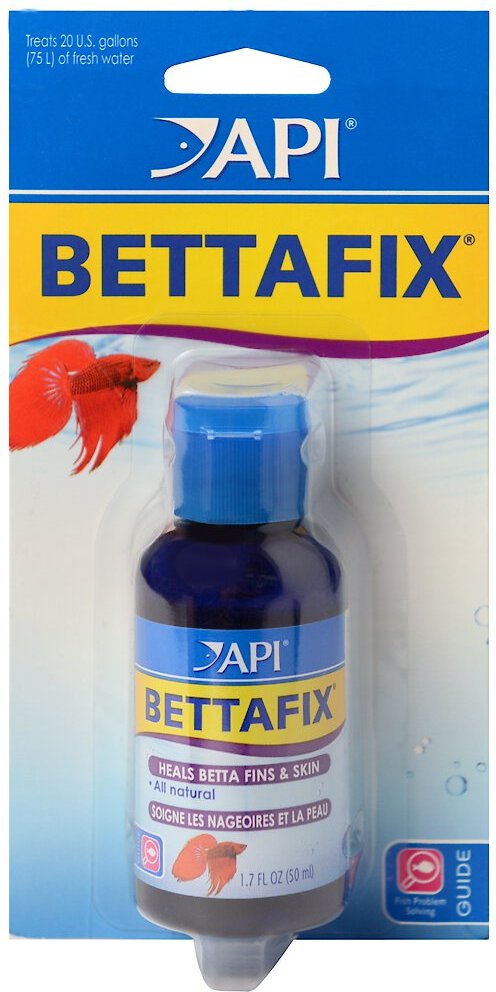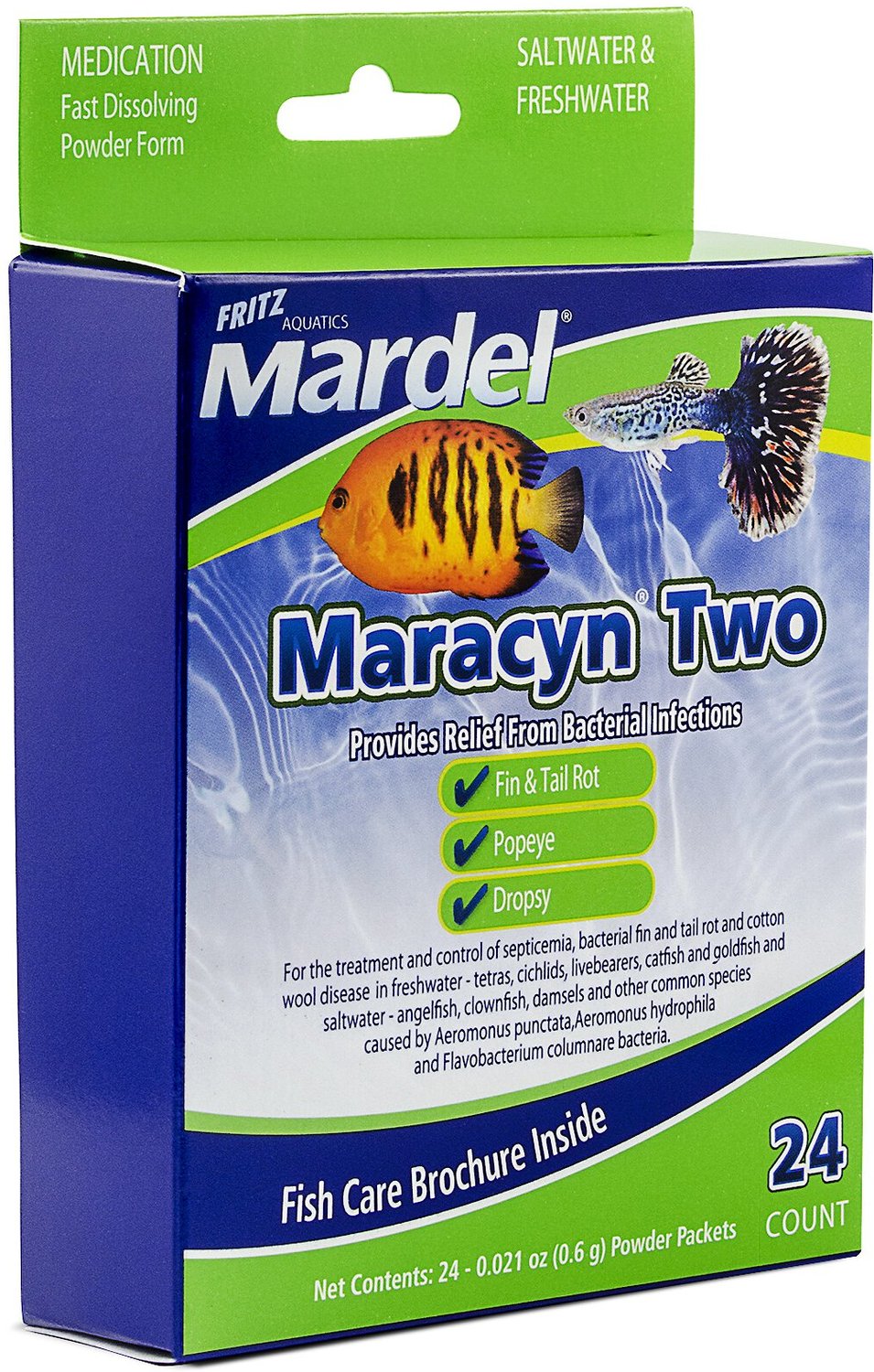What Causes Fin Rot In Bettas (Symptoms & Treatment Guide)
Unfortunately, when it comes to fin rot, betta fish really suffer. It’s a common condition that can make your betta uncomfortable and unhappy. You may not even notice betta fin rot symptoms at first, but treating the disease quickly is the best way to avoid severe fin rot developing. So what does fin rot look like, what causes fin rot in bettas, and what’s the best way to treat it?
When betta fish fins rot, it’s caused by a bacterial infection, often triggered by poor water quality and stress, lowering your betta’s immunity. The result of fin rot is decaying fins and loss of tissue, leading to your betta losing its beautiful colors. White milky fin edges are a good sign of a fin rot infection.
Common Names: Fin rot, fin melt, body rot, mouth rot, and gill rot.
Scientific name: The bacterial form of fin rot is known as Pseudomonas fluorescent.
Betta Fin Rot Symptoms: Uneven, ragged, and stringy fin tips that are pale, yellowing, or dark brown in appearance. Maybe signs of mucus covering the infection area. Fungal Infection will look white and fluffy, eating away at the fins more evenly.
Cause Of Betta Fin Rot: Fin rot is an infection with bacteria often caused by injuries, lowered immunity, or poor water conditions. Betta fish living in poor conditions or poor health are more susceptible to a number of “gram-negative” bacteria such as Aeromonas, Pseudomonas fluorescens, or Vibrio. Fungal fin rot is often more likely to appear on injured tissue.
Fin Rot Treatment: Antibiotics for jagged fins (bacterial infection) or a suitable antifungal treatment for fin rot that is more even. Aquarium salt can ease discomfort and promote recovery. Many suitable commercial treatments are available, such as malachite green, phenoxyethanol, or methylene blue.
Outlook: Unless severe infection has taken hold, causing severe fin and body tissue damage, fin rot treatments are often successful, and most fish will fully recover.

If your betta has fin rot, I highly recommend you keep reading as I will explain the causes of betta fish fin rot, how to spot the symptoms, and how you should treat the condition if it does show up! Finally, I offer some tips on fin rot prevention.
Also, make sure to check out our betta fish care guide.
What Does Betta Fin Rot Look Like
It’s easy to miss the signs of a fin rot infection unless you know what you are looking for. The longer it goes undiagnosed, the more damage it can do and the harder it becomes to treat.
The most obvious signs of betta fin rot are:
- A betta’s fin tips become pale, milky white, dark brown, or yellowish instead of their usual vibrant colors. After a fin rot infection, a bettas fin edges can appear transparent as they grow back.
- Parts of the fin will rot and fall off (this can happen within a few days!).
- Fins become stringy or frayed with jagged edges.
- You may notice that your betta fish has a mucus-like film on its body, indicating a fin rot infection.
When the fin rot infection is fungal, the fin edges are less stringy and frayed and, instead, appear more white and fluffy and rot away more evenly,
With severe fin rot, betta fish have quite a hard time and often stop eating and sleeping, which makes them grumpy. A male betta’s fins are large and flowing, so when fin rot sets in, the fragile membrane can become heavily affected, often causing a large amount of fin loss.
When a betta suffers from fin loss, it will eventually grow back, however, the quicker you can spot the onset of fin rot, the quicker you can treat it. If diagnosed quickly, your betta may only suffer from minor fin loss around the edges.
The video below will give you many examples of what betta fin rot looks like.
What Causes Fin Rot In Bettas
Betta fin rot is a common bacterial disease. Dependent on where the infection is found, it may be referred to as tail rot, gill rot, mouth rot, or body rot.
There are many ways betta fish can contract fin rot, but it’s important to understand the most common causes so you know how to prevent them!
There are several causes of fin rot on betta fish, such as:
- Stress.
- Poor water quality.
- New Tank Syndrome.
- Injuries from betta fish fighting or fin nipping.
- Parasites (eustrongyloides) can cause fungal infection (fungal fin rot).
- Keeping the aquarium heater at the wrong temperature.
If any of these bacterial infections are left untreated, the fish will usually die.
The main cause of betta fish fin rot is poor water quality. Your tank needs to be clean and sanitary to prevent harmful bacteria from building up. Poor water quality can also lower immunity in betta fish, making them more susceptible to bacterial infections. Check the ammonia, nitrite, and nitrate level every week, or you may develop the perfect breeding ground for harmful bacteria.
Bacterial fin rot can be caused by many types of “gram-negative” bacteria which eat away at and dissolve the delicate tissue and membranes around the fins.
Some fin rot infections can appear white and fluffy, often referred to as fungal fin rot. It’s most easily noticed when your betta fins turn white at the edges.
If you have a sick betta fish, fin rot is much more likely because the immune system is compromised. Parasites and bacteria are often present in a betta tank just waiting to strike, so when a betta’s immunity is down, this is the best time for fin rot to occur.
Mycobacteriosis
Mycobacteriosis is a more serious bacteria that can evade the most common fin rot treatments. If treatments do not seem to clear the infection, mycobacteriosis is probably the cause of the infection.
Is Betta Fin Rot Contagious
Bacterial fin rot on betta fish is very contagious. If your betta has bacterial fin rot, the whole fish tank will be saturated with the harmful bacteria that cause it. Keeping tank mates apart won’t stop the bacteria from spreading to other fish in the tank, so you will need to treat the entire tank.
Although fin rot is contagious, your betta will still need a lowered immunity for the bacteria to take hold. As I mentioned previously, the harmful bacteria that can cause betta fin rot are common and often go unnoticed without ill effects.
What Does Fin Rot Look Like On Bettas
Fin rot is quite easy to spot in the later stages, as your betta’s fins will look soft and mushy around the edges. At this stage, your betta fish may be losing large sections of their fins.
Often fin rot will turn the fin edges a dark brown color, or if it is fungal, the fins may become white, but the fins will appear like they are rotting.
Soft edges are most common as fins tend to rot quite evenly, whereas sharp edges may be caused by fighting or damage from sharp rocks, which I’ll talk about in a moment.
When a betta’s fin rot is in the early stages, it may be difficult to tell from a visual inspection, so you will need to look out for early symptoms of illness.
The next section looks at a full list of symptoms to help spot fin rot from its earlier to later stages.
Betta Fin Rot Symptoms
Because fish are more vulnerable to fin rot when they are already unwell, looking for signs of general illness is a great way to catch fit in the early stages. Apart from looking at your betta’s fins, there are several other symptoms you can look out for.
Below is a list of the most common symptoms of fin rot, but remember that some symptoms may signal that a betta is generally unwell. Either way, it’s the perfect time to check water parameters and cleanliness to prevent infection.
- Lethargy – Your betta may stop moving around, staying in one place for long periods.
- Betta not eating – Loss of appetite.
- Dark brown, gray, or white patches on the fins and body. These patches are usually found on the fin edges or where the body meets the fins. Fungal fin rot appears lighter and more fluffy or cotton-like.
- Rubbing their body up against objects in the tank or other fish to get relief.
- Finding your betta hanging at the top of his aquarium, unable to swim downwards. This is because he feels he has no energy left to move around.
Some of the symptoms above are also commonly seen in diseases like white spot, better known as ich/ick.
If you haven’t treated the fin rot early enough, the rotting patches will eventually spread across other body parts.
Betta Fin Rot vs Fin Loss
It is sometimes hard to distinguish between fin rot and fin loss caused by other tank mates nipping at your betta’s fins.
Betta fish can be aggressive toward other aquarium fish, often becoming injured and losing their fins. Betta fins are delicate and attract a lot of attention from other fish.
In my early years of fishkeeping, I added a betta fish to my own community tank. The betta seemed a little timid, and I guessed it was because of the new environment. The following day I looked In my fish tank but couldn’t see my betta anymore.
After 20 minutes of looking, I noticed a strange, finless creature wobbling around the tank. IT WAS MY BETTA!! which soon died.
Not understanding why this had happened, I tried one more betta and discovered that both my Angelfish and Gouramis were nipping at my betta’s fins until the gorgeous plumage was all gone.
This is a drastic case of fin nipping, usually only seen on a much smaller scale. As betta fish have such long wavy fins, they are an easy target for most fish to nip at, and this will cause many recurring infections.
The damage caused by fin nipping will often progress to fin rot as the damaged fins are more susceptible to bacteria and parasitic infection.
Fin Rot Or Fin Nipping
It is usually quite easy to distinguish between fin rot and fin nipping.
The most common signs of fin-nipping are:
- The fin edges will appear clean-cut if caused by damage from other fish. Fin rot would appear as tattered and frayed fin edges.
- Ripped fins or split fins can be caused by fighting, or sharp objects can cause damage during fighting.
- If you have recently added a new fish to the aquarium, then it is highly likely that they are responsible for nipping at your betta’s fins.
- A timid betta hiding out in the fish tank could be having its fins nipped.

As I mentioned earlier, damage caused by nipping can be the trigger for betta fin rot to set in, so it is important to quickly move the perpetrator to a separate tank or a separate container if you only have one tank.
If your betta fish’s fins begin to rot, it is quite easy to distinguish from nipping because the mushy dark appearance will usually stand out quite well compared to the usual bright colors.
Betta Mouth Rot
Betta mouth rot is a bacterial or fungal infection called mouth fungus, cottonmouth, or cotton wool disease because it appears like mold or a white wooly fungus. Betta mouth rot is caused by Flexibacter Columnaris or Flavobacterium Columnare bacteria.
Early Stage Betta Mouth Rot
In the early stages, your betta’s mouth rot may cause a loss of appetite due to the discomfort caused inside its mouth. At this stage, you may notice small strings of a white, cotton-like substance protruding from your betta’s mouth.
As mouth rot progresses, you will certainly notice a white substance coming out of your betta’s mouth, and mouth rot can quickly spread to the gills, causing gill rot and breathing problems.
Treatment for betta mouth rot is the same as fin rot which I will describe in more detail below. However, a simple over-the-counter anti-bacterial medicine should be quite effective in most cases because it is a bacterial infection.
During a case of mouth rot, it would be worth changing your betta’s diet to something more manageable other than pellets. The best food for betta fish will be something soft and easy to eat. Your betta won’t want to chase live food around the tank when they have mouth rot, so frozen or freeze-dried foods like baby brine shrimp or bloodworms will help.
How To Treat Betta Fin Rot
One key factor in successfully treating betta fin rot is recognizing it early. Betta fin rot can be caught at many stages, and you will often treat fin rot differently at each stage. Early-stage fin rot will cause less initial damage and be easier to treat.
Always check water parameters and water temperature first.
Treating Mild Fin Rot On Betta Fish
Mild fin rot is when caught at its earliest stage. The fin edges are usually affected and may look soft and melted.
Mild fin rot treatment is usually more simple. Just add aquarium salt to the aquarium water. You can buy aquarium salts at most pet shops, and you just need to follow the guidelines on the label.
Medication may or may not be necessary. If you don’t feel the infection is clearing or don’t want to take the chance of it spreading, use one of the medications listed below for moderate fin rot.
If you are in mild fin rot stages, you should check the water quality in your aquarium and ensure the proper temperature is set and maintained.
Poor water quality and high ammonia levels are the main contributing factors to fin rot infections, often caused by uneaten food debris, poor filtration, and a general lack of cleaning.
All of these factors will eventually lead to a build-up of harmful bacteria, which can cause fin rot.
It is important to carry out regular water changes and use a gravel vacuum to remove any debris from the substrate. Regular water changes will keep bacteria levels down, and the result should be healthy fish.
Treating Moderate Fin Rot In Betta Fish
Moderate fin rot will need immediate attention, especially if your betta has an aggressive personality.
If you have caught the fin rot at this stage, immediately move the infected fish to a quarantine tank, as it will be easier to treat.
As mentioned above, aquarium salt can help heal mild or moderate betta fin rot, but you need to ensure the salt saturates throughout the tank.
Using betta fin rot medication, you can treat any type of rot easily and effectively without adding salt.
Three medications that I have found effective against betta fin rot are:
BettaFix For Fin Rot by Aquarium Pharmaceuticals
MelaFix For Fin Rot (Malachite Green) 16 Fluid Ounce Bottle
Fritz Aquatics Mardel – Maracyn 2 Antibiotic Treatment
These medications can cure mild to moderate betta fin rot in only one day, but you need to change 50% of your fish tank water before adding this product, and it can be harmful to live plants or invertebrates.
All of the medications I have mentioned are highly recommended as they act fast and only need minimal changes to your tank conditions.
Many more medicines are available, and you should always check whether they treat bacterial, fungal, or parasitic infections.
Moderate betta fin rot treatment can also involve adding aquarium salt daily until the infection clears up. This will not cure the fin rot infection, but it will help to relieve discomfort and reduce stress.
How To Treat Severe Fin Rot In Betta Fish
Severe fin rot treatment is more time-consuming, will take longer to act, and is often far less effective. Advanced fin rot can cause a fast decline in the health of your betta fish, and there is a risk it may die.
Ideally, move your betta to a hospital or quarantine tank as soon as possible. The quarantine tank will stop other fish from contracting fin rot so easily.
Change your aquarium water every day and add betta fin rot medication twice daily for up to five days.
You should notice a difference after only one day of treatment, but ensure you complete the full course until all signs of infection have gone away completely before stopping the medication.
Using betta fin rot medicine means you don’t need to change your aquarium water so drastically.
If the betta is still eating, it will tolerate a small amount of medication in the tank. If your betta stops eating, this would be a problem and potentially be a sign that your betta is dying.
In this case, immediately remove all medications from the tank and do a 50-60% water change to lower the medication levels.
It is important not to over-medicate your betta and always follow the manufacturer’s dosage advice exactly.
Although betta fin rot treatment should be easy, you must ensure that any medications used will not harm other fish or plants in your aquarium, as this could lead to secondary infections, which are harder to treat.
Can Betta Fin Rot Heal On Its Own
It is possible that fin rot can heal on its own. A betta will usually become more susceptible to the infection if the immune system is down. Should the betta’s immune system improve, it may fight the infection without medication.
Personally, I wouldn’t rely on this happening and would always want to treat an infection as early as possible as bacteria and parasites can spread quickly through the aquarium water.
If you have a community tank, other fish risk contracting fin rot.
How Long Does Fin Rot Take To Heal
How long your betta’s fin rot takes to heal is difficult to answer. The infection can be treated and cleared relatively quickly, although the physical scars need time to heal.
Betta fish will experience fin regrowth over time (usually several months), and the fish’s body will heal quite quickly. Providing there is no major fin damage, you will need to wait patiently and nurse your betta fish back to health.
How To Tell If Your Bettas Fin Rot Is Getting Better
You can tell if fin rot is getting better by your betta fish’s general mood, and the fins should appear less mushy.
It does take time to notice physical signs of improvement, such as the color and shape returning, as there needs to be some fin regrowth first, so it is easier sometimes to make sure the condition is not getting any worse.
As long as the fin damage has stopped, you can be assured that the fin rot has been cured. During the fin-regrowth stage, fins that grow back have a transparent appearance and are very fragile. Once the color returns they should be fully formed.

How To Prevent Fin Rot In Betta Fish
The best way to treat betta fish fin rot is through prevention, so let’s find out how to prevent betta fin rot and ensure you take all the necessary steps.
To prevent fin rot, it is advisable not to overcrowd your aquarium and keep the water clean at all times, checking water parameters regularly. I have a great post on how often to change betta water.
This will also reduce stress levels in your betta fish which could cause their immune system to be compromised as they fight off infections or parasites.
Also, you need to ensure you are not overfeeding your betta. Feed only what they can eat in two minutes and remove any uneaten food after this time as it will pollute the water and increase nitrate levels which could lead to fin rot developing.
If your betta fish needs a clean tank with plenty of space, it will boost its immune system. They will not feel overcrowded and will be much less likely to contract fin rot.
The steps to prevent betta fin rot are pretty simple, but too many fish owners will ignore the basics and end up having to treat fin rot instead, with potentially devastating consequences.
Wrap Up
Betta fin rot is a preventable disease that’s caused by too much stress on the fish. If your betta has an open sore or wound, it will be prone to infection and could worsen if not treated immediately.
If you notice any of these symptoms in your pet, make sure to take them to the vet for treatment as soon as possible. It’s best to avoid this problem altogether with simple steps like keeping your tank clean so bacteria don’t grow there and being mindful about how you feed them food – they’ll be less stressed when eating well!












